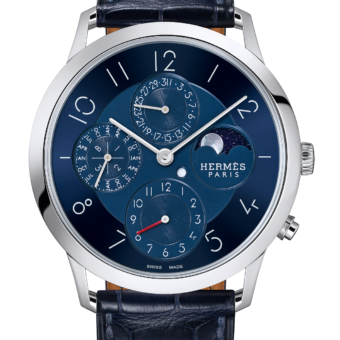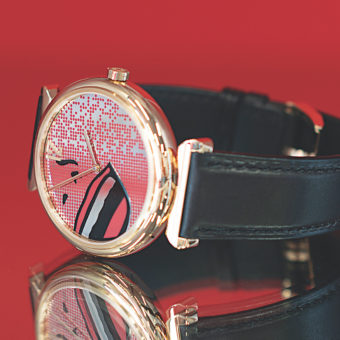Patek Philippe’s perpetual calendar chronographs are among the most collectible of all timepieces. References such as 1518, 2499 and 5970 are spoken of reverently, and the phrase “holy grail” often slips into the conversation. So when a new reference comes on the scene, the event commands attention. When it has a new manufacture movement, the occasion is doubly important.
All images may be enlarged with a click.

Patek Philippe created the world’s first perpetual calendar in 1925. In 1941, the reference 1518 perpetual calendar chronograph was launched, and collectors have been pursuing that combination of complications ever since.
The face that launched a thousand dreams: Patek Philippe Ref. 1518.

The 5270 replaces the venerable 5970, so expectations are high. Collectors scrutinize every square millimeter of the new model, debating the smallest details. Auction prices for the outgoing reference rise and fall on speculation about its replacement.
A side-by-side comparison of the 5970 (below, left) and 5270 reveals that while many details have changed, tradition has been served.

The 5270 offers technical and aesthetic updates in abundance. Its case is slightly larger at 41mm versus 40mm, and thinner by .6mm, but more importantly, the new dial has a visible diameter of 32.4mm and the tachometer scale has been removed, enhancing the perception of increased size and openness. The leap year cycle is displayed numerically in a small, round aperture at 4:30, and day/night is displayed in an aperture at 7:30. These displays are easier to read than the 5970’s tiny hands on the subdials at 3 and 9 o’clock. Due to the configuration of the new manufacture caliber, the 5270’s seconds subdial and the 30-minute counter are positioned beneath the horizontal centerline, shifting the “weight” of the dial to the lower half.
Overall, the new 5270 dial is cleaner, more modern, and easier to read. Some might say the 5270 looks less complicated than its predecessor, and that is not a bad thing when clarity is the object of the exercise.
The 18K white gold case remains a classic three-part construction manufactured in-house with the traditional cold-forming technique. The white-gold chronograph pushers exhibit the same shape as those found on Patek Philippe chronographs from the 1940s and 50s. The lugs, also inspired by earlier models, display more character than those on the 5970. The screwed display back with the sapphire-crystal window showcases the manufacture movement beneath. A solid caseback is also included.
In 2009, Patek introduced its new manufacture chronograph caliber CH 29-535 PS. The 5270 uses this movement, with the addition of a new perpetual calendar module. As WatchTime’s Norma Buchanan wrote after attending the chronograph caliber launch in Paris: “The new chronograph is what Patek calls ‘classic’ in its structure, meaning that it has a column wheel and a horizontal clutch. But it has much that’s new besides.”
Patek Philippe Manufacture Caliber CH 29-535 PS.

For example, the engagement and disengagement action takes place in the traditional manner with the driving, clutch, and chronograph wheels, but instead of the conventional triangular teeth, these wheels have newly calculated and patented toothing profiles that Patek claims reduce wear, boost efficiency, and prevents tooth tip collisions. As Buchanan wrote, Patek said these enhancements eliminate the jumping motion that chronograph hands sometimes make when the chronograph is started, and the tooth profiles reduce friction so much that the chronograph seconds can be kept running continuously.
The clutch and chronograph wheels engage.

Moreover, the engagement of the wheels is adjusted with the slightly eccentric column-wheel cap that precisely defines the position of the clutch lever at its outermost point. Further optimization takes the form of self-setting hammers pivoted between jewel bearings, the synchronization of the brake lever with the clutch lever, and the slotted minute-counter cam that prevents the abrupt deceleration of the wheel in response to a reset command. In all, the new chronograph caliber incorporated six patent-pending inventions.


To this base, Patek added perpetual calendar functions by developing a new mechanical calendar module. Patek says it took two years to perfect the 1.65-mm high traditional cam-controlled calendar mechanism, which has 182 parts, bringing the caliber’s total part count to 456.
Looking through the display back, several fine finishing details are evident. Steel parts in the going train and the calendar mechanism exhibit manually satin-finished flanks and straight-grained surfaces as well as chamfered and polished edges – and as opposed to flat 45° bevels often imparted by machines. The chamfers are slightly convex, a typical Patek Philippe detail. Steel wheels and pinions are also carefully finished: all teeth and leaves are individually polished by hand using a rotating hardwood disk. This work yields aesthetic and technical benefits: smoothly polished surfaces generate less friction, reduce wear, and transmit kinetic energy more efficiently.







